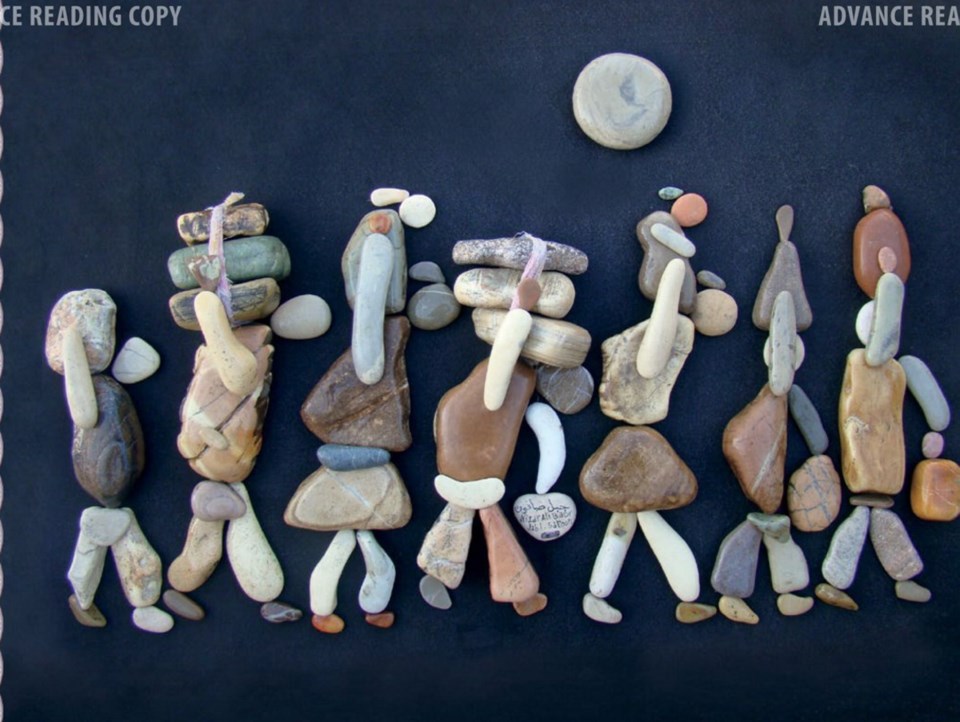While browsing Facebook one day, Salt Spring Island writer Margriet Ruurs’ eye was caught by a tender image of a mother holding her baby. Behind the mother, a father walked along carrying a heavy load.
“It touched me deeply. But the amazing thing was the medium. The image was not painted. It was not drawn. It was composed entirely of stones,” Ruurs writes in the forward to her book Stepping Stones: A Refugee Family’s Journey. “Wait a minute, I thought. How can stones display such emotion? Who is the artist who can breathe such life into solid rock?”
Ruurs’ search for the artist was the beginning of her own journey of discovery. It has culminated in the publication of the English-Arabic picture book about a young girl and her family forced to flee their peaceful village to escape civil war and make their way to safety in Europe.
“Canada has always been a land of immigrants and refugees, and this book will help to spread that message and encourage others to contribute to a desperate cause,” said Bob Tyrrell, president and founder of Orca Book Publishers.
“The book has the potential to be a significant fundraiser for refugee resettlement organizations across the country. This is also a good opportunity to bring a bit more much-needed attention to this important social issue.”
Orca will donate $1 from the sale of each copy of the book to refugee resettlement, said Tyrrell, who along with his wife Avril is involved with a group sponsoring a Syrian refugee family. Ruurs is donating her royalties to help settle more refugees.
Orca is also offering the book as a fundraiser to schools and other organizations involved in refugee work at a 50 per cent discount. This will allow them to raise $10 per book sold, says Tyrrell. Last week, Orca sent promotional material to 17,000 schools and other organizations across Canada.
Stepping Stones will have its offical launch at the Greater Victoria Public Library on Saturday between 2:30 and 4:30 p.m.
Like many, Ruurs was familiar with the Syrian refugee crisis and the desperation of those trying to cross the Mediterranean Sea in unsafe boats. But the stone images struck her strongly. She noticed one of the stones was signed Nizar Ali Badr and found Badr’s Facebook page filled with beautiful images. Ruurs was inspired to create a story that could be illustrated by him.
“Each image told a story expressing love, anguish, sorrow or joy. I learned that Nizar was a Syrian, and it soon became evident that much of his work was inspired by the war that has engulfed his country,” writes Ruurs.
“In his art, I saw people changing from happy, carefree children into people burdened and fleeing. There was hurt and sorrow. But ultimately there was also love and caring. And amazingly, all this was told with stones.”
But trying to contact a stranger in war-torn Syria was not easy. Ruurs sent Badr messages on Facebook. She received no reply. Ruurs realized he might not understand English. Next, she wrote Badr a letter and asked a friend to translate it into Arabic for her. When Badr still did not reply, Ruurs wondered if he was still alive.
A recent Facebook post confirmed he was, so Ruurs asked a friend in Pakistan to try to contact him. She learned that Badr’s Facebook page had reached its friends limit and he was not getting her messages. Her friend in Pakistan finally managed to get a message through to Badr. He replied that Ruurs should contact him through his friend Saji, who speaks English.
Ruurs learned that Badr collects stones on the beach for his work, but cannot afford glue to give permanence to his art. When, he agreed to work on the book with her, Ruurs contacted Tyrrell, who immediately agreed to the project.
Ruurs hope to raise awareness of the plight of those who have to flee the horrors of war.
“But I hope it conveys, too, a sense of peace and love, of people helping one another. I am also happy to have played a part in bringing the work of the wonderful artist Nizar Ali Badr to an audience he might not otherwise have reached,” Ruurs says.



